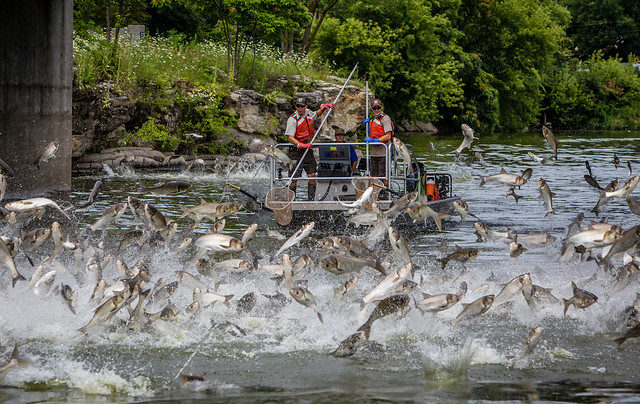Army Engineers Finalize Asian Carp Plans [VIDEO]
$778 million dollar project aims to keep invasive fish out of Great Lakes

Video credit: U.S. Fish and Wildlife Service
The Mississippi River is teeming with Asian carp, which have taken over the territory of native fish. And they could do the same thing if they reach the Great Lakes in large numbers. The U.S. Army Corps of Engineers wants to make sure that doesn’t happen. The agency has submitted a proposal to Congress to prevent the invaders from reaching Lake Michigan through a human-made waterway that links the Great Lakes Basin to the Mississippi. The agency is considering several steps to keep two species of carp from going beyond the Brandon Rd. Lock and Dam in Joliet, Illinois.
“One of them would be additional electric fencing,” says Nick Schroeck, director of clinical programs at the University of Detroit Mercy School of Law. He’s referring to cables that send electric current up from the bottom of the canal toward the surface of the water.
“When the carp swim up toward that current, they get shocked, they don’t like it, and they turn around,” Schroeck says.

Why are Asian carp a threat to the Great Lakes, and how did they get into the U.S.?
We’re talking about two kinds of fish here, the bighead and the silver carp. You may have seen the latter in online videos, which show large numbers of carp jumping out of the water, hitting boats and people in some cases. The bighead can grow to about 6 feet long and weigh around 200 pounds.
Nick Schroeck says these species were brought to the southern U.S. intentionally in the 1970s for — somewhat ironically — environmental reasons. Fish farms used carp to eat algae, thus keeping their water supplies clean. Wastewater treatment plans also saw carp as a “green” solution.
“They were going to use these carp to help eat waste,” Schroeck says.
Eventually, flooding enabled the fish to spread beyond these limited areas and into the Mississippi River, Since then, they’ve been swimming north toward Chicago, crowding out native fish and overtaking the food chain.
“They are voracious eaters,” Schroeck says. “They’re not native to this area, and they don’t have any natural predators.”
Schroeck says in some parts of the Mississippi, Asian carp make up more than 80% of all aquatic life. Schroeck says if that happens to the Great Lakes, it would damage an important part of the region’s economy.
“Our native fisheries generate a lot of money,” Schroeck says. “We’re talking $7 billion or $8 billion a year between commercial and sport fishing in the Great Lakes.”
In June, members of Michigan’s congressional delegation plan to visit the Brandon Rd. Lock and Dam to get a first-hand look at efforts to control Asian carp.
Click on the audio player to hear the conversation with WDET’s Pat Batcheller.
Asian Carp Control Measures by WDET 101.9 FM on Scribd
